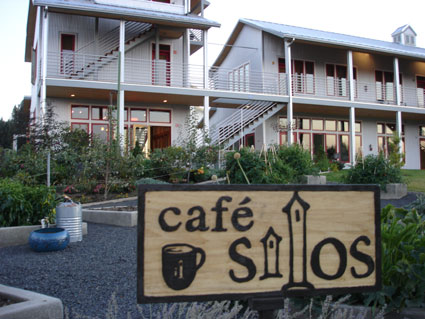Cafe Silos: Coffee Conquers Asphalt
This is part of my interview with Brenda, owner of the Cafe Silos. It’s probably the best coffee shop in Moscow that you’ve never heard of. Besides the fact that most people don’t know where it is, it’s not immediately apparent how to get there with your car. Why the unusual location? It turns out that trying to implement “smart growth” and mixed-use real estate is a lot harder than you might think.

Brenda: Main street is where you would want to have a coffee shop. You have all the signage and access and we don’t have access. We don’t think cars are the most important access. So there might not be access for cars but there is really good access for bikers and walkers. The path is right outside.
MCR: Well, and there are a lot apartments close buy, so I figured you were aiming at those people who could walk here easily.
B: And, it takes about 59 seconds to drive around. So there IS plenty of access and it’s not that difficult to figure out.
MCR: Well, it’s a real pretty place. Did you decide first that you wanted to build an apartment complex and then after that you decided to put businesses in the bottom of it?
B: It’s a funny story. The church sold us this because it’s a strange lot.
MCR: Oh, right, it’s a funny piece of land.
B: The city wanted to put a street through here, and they offered the church $600 for this lot. So I work at Moscow Realty and I got a call from them asking if I thought this piece of land was worth $600. So I said, well, let me look at it. I looked at it, it’s multi-family, it’s big enough to put at least 20 units on it. It’s definitely worth a lot more than $600. Then we communicated with the city saying it was a little bit low. They said it was a typo and they meant $6000. One thing led to another and eventually Moscow Realty was representing the church. I was representing the church. It’s a long story with the church, but at one point the church HAD to get rid of this lot so they sold it to Rob Davies. So he owned it and he wanted to put apartment units on it. The city’s interest was contrary to ours. They wanted to put a street through it. And so we went back and forth on it for about 4 years, and one day it was just so difficult, I said to the city attorney, what you think we want to build a coffee house there? Because at that moment, I knew the one thing that was not allowed in that zone was a coffee house. And then he said a few more things to me and I said, you know what? Let’s put a coffee house on the application.
B: [The rooms of the shop] are designed in such a way that they could become two apartments if the coffee house failed. It’s part of smart grown and mixed use. So it’s from a real estate growth perspective that it grew.
MCR: I’m really surprised you had so much trouble, I thought the city really wanted this smart growth stuff and integrating residential and services but then when you actually go to do it, you run into a wall.
B: Not the city staff. The staff do not want to bother with it. They just churn out the same thing.
MCR: Have you had the same experience in other dealings with them?
B: Yeah, we had a development project north of town that staff sabotaged. This is not a community development staff that believes in smart growth.
MCR: The coffee shop was just kind of thrown in there on the side? You’re not a big coffee lover?
B: Well, I appreciate a good cup of coffee. We thought we might sell the shop, but we never got any takers. The thing is, when people think of a coffee shop you think of a couple of things. First you think of Starbucks and emulating Starbucks. And the second thing you think of is you have to have access. You want something where people can just drive by and you’re going to make lots of money. This is a no-money making proposition.

B: And the garden design is mainly so if the city comes to put a street through, they destroy a really nice garden.
MCR: That’s why the garden is there?
B: Yeah, that’s exactly why it’s there. Because you think about a city who has all the power to take something through eminent domain and who kept us from doing this project for four years and even when it was finally done, came out here and wouldn’t give us our occupancy certificate until we planted a couple more trees. And you can see how much landscaping there is here.
MCR: There’s a ton!
B: Yeah, so the community development person comes out and says, Oh, you need a few more trees. And I said, well, where would you like them? He says, I want some over there and some over there. And the way we resolved it was I took some twigs from a maple tree and stuck them in the ground, called him up and said, the trees are in. He came out, he didn’t know what he was looking for, because he would have been embarrassed if he realized it. And then the department had to give us our certificate. So it was those kinds of obstacles that they put in our way all the time. But we’re here now and we’ll stay.
Filed under: Cafe Silos, Interviews on September 29th, 2007
Leave a Reply